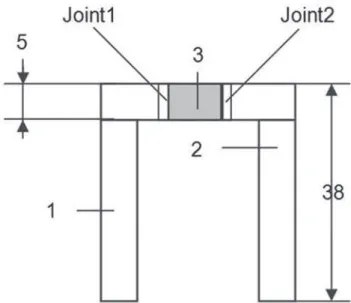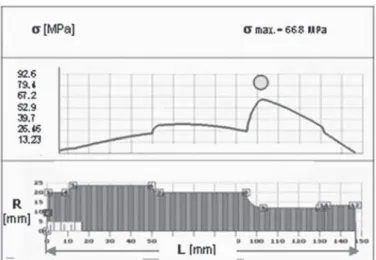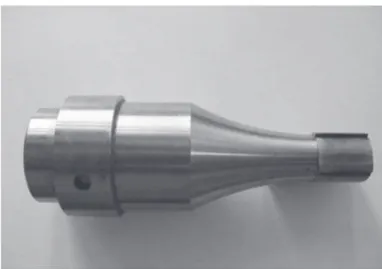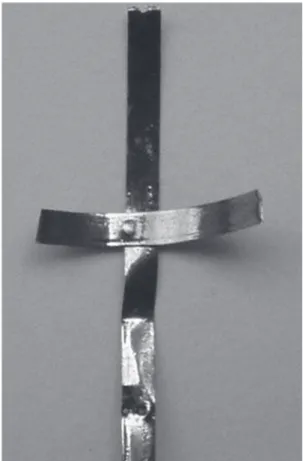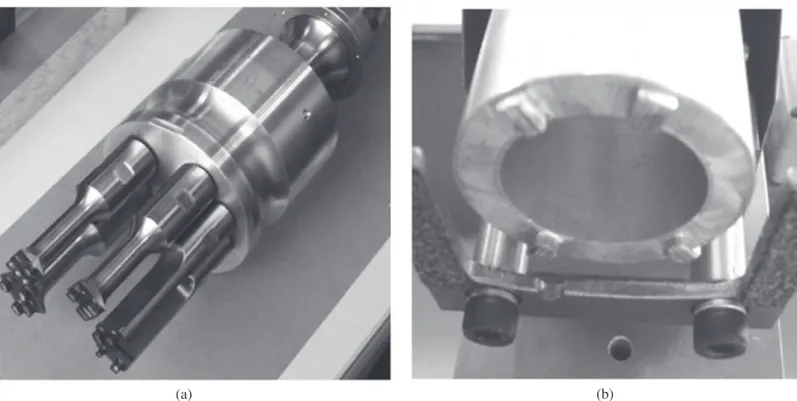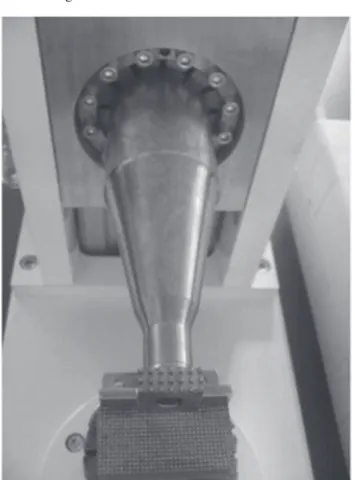(Recebido em 09/11/2009; Texto Final em 08/12/2009).
(Melhorando a Produtividade e Qualidade na Fabricação em Plástica e Chapas Finas de Metal por Soldagem por Ultra-Som)
D. Dehelean1, O. Oanca1
1 National R&D Institute for Welding and Material Testing ISIM, Timisoara, Romania, ddehelean@isim.ro
Abstract
The paper presents an overview of the research done at the Romanian National R&D Institute for Welding and Material Testing ISIM Timisoara in the field of ultrasonic process development. It starts with a general presentation of the value added by the welding sector in Europe. There are presented figures representing the size of the welding sector in Romania. The need of development of new high efficiency welding processes is mentioned, ultrasonic welding being one of the special welding processes with exceptional application perspectives. Practical examples of industrial application of the ultrasonic welding process for joining plastic and metallic materials are presented. A special case study refers to the welding of new shape memory alloys. The use of the ultrasonic welding instead of an conventional welding process has lead in each presented case study to an increase of the efficiency of the welding process through higher productivity and saving of manpower, consumable, energy.
Keywords: Ultrasonic welding, process development, metal welding, plastic welding, shape memory alloys welding, applications, efficiency
Resumo:Este trabalho apresenta um panorama dos trabalhos de pesquisa conduzidos no Instituto nacional Romeno de P&D em Soldagem e Avaliação de Materiais (ISIM – Timisoara) no desenvolvimento de processos ultrassônicos. Ele se inicia com uma apresentação geral pelo valor adicionado pelo setor de soldagem à Europa. São apresentados valores representativos do tamanho do setor de soldagem na Romênia. A necessidade do desenvolvimento de novos processos de soldagem de alta eficiência é mencionada, sendo a soldagem ultrassônica um dos processos especiais de soldagem com perspectivas excepcionais de aplicação. Exemplos práticos da aplicação industrial deste processo de soldagem para a união de plásticos e de metais são apresentados e um caso especial se refere à soldagem de novas ligas com efeito de memória de forma. O uso de soldagem por ultrassom no lugar de um processo convencional de soldagem resultou, em cada um dos estudos de caso apresentados, em um aumento da eficiência do processo de soldagem através de uma maior produtividade e da economia de mão de obra, consumíveis e energia.
Palavras-chave:Soldagem por ultrassom, desenvolvimento de processos, metal, plástico, efeito memória de forma, eficiência.
1. Introduction
Welding is present in all industrial sectors as a key technological process. The volume of application of welding processes has known a spectacular ascendant evolution; over 80 welding processes are industrially used, today. Studies made in different countries such as Germany or USA has assessed the dimension of the welding sector and its great contribution to the added value created by the manufacturing industry.
Recent analyses showed that the value added by the welding sector in the European Union was 86 billions euro at the level of the year 2007; in realizing this value over 2.1 millions of employees contributed, [1]. Both the value added and the
number of employees involved represent 6% of the values corresponding to the whole European production sector. From the total added value of 86 billion euro, 6.9 billions euro (123 000 employees) is the contribution of the production of welding material, equipment, complementary goods and services, and 79.1 billions euro (2 026 000 employees) result through the application of joining technologies.
Welding represents a key technology for a series of industrial sectors in Romania, too. The size and the level of the Romanian welding sector can be appreciated by following figures:total steel consumption 4,249 thousand tons/year, weight of realized welded structures 1,912 thousand tons/year, mass of deposited metal 32 thousand tons/year, number of welders 37600, welding mechanization level 48.1%, [2].
like laser – arc or ultrasonic – resistance welding and thermal spraying processes, respectively.
Within the presented paper are given, as examples, several achievements of ISIM in the field of ulttrasonic welding.
2. Ultrasonic welding
2.1 General data
Compared with conventional welding processes the ultrasonic (US) welding process is applied on a smaller scale, but it has exceptional development perspectives regarding productivity, efficiency and quality for different industrial sectors, e.g. in automotive industry, electrical engineering, microelectronics and medical devices, respectively for joining of new materials, e.g. biocompatible, smart composites or shape memory alloys. The main researches activities on the field of ultrasonic welding are focused on:
characterisation of welding behaviour of different base
•
materials (copper, titanium, plastics and also new materials, e.g. shape memory alloys, biocompatible and composite materials)
design of specialised equipment, including resonators
•
development of welding procedures for specific industrial
•
applications
The high applicative potential of the ultrasonic welding process is illustrated in the following sub-chapters with applications both for joining plastic and metallic materials, including memory shape alloys.
2.2. Ultrasonic welding of metallic materials
2.2.1 Ultrasonic welding of electric shunts
An electric shunt composed by 3 parts is assembled by 2 joints, figure 1. The base metal is copper for the terminals and nickel coated copper for the central part, (1.5 mm thickness).
The original joining procedure used by the producer is flame brazing, a process characterised by a reduced economic efficiency. In order to increase the efficiency of the fabrication process the US welding technique appeared as an interesting joining alternative. In this case the two welds can be realised
Figure 1. Electric shunt. 1 and 2 - terminal, 3 – shunt.
Figure 2. US welding machine.
A specialised welding equipment with a power of 3000 W, 20 kHz (figure 2), was developed for this application. Considering the customer’s requirement to maintain the investment expenses as low as possible, the resonator was made of high quality carbon steel. For increasing its life service it was provided with two active surfaces, [3].
In order to determine the amplitude, the stress, the strain energy and the loss in the sonotrode and to optimise its geometry a simulation using specialised software was performed. Figure 3 presents the variation of the sonotrode stress with its length. The maximum stress which appears in the critical area with stress concentrator is 66.8 MPa, being lower than the fatigue resistance of the base material.
For comparison, the stress variation for a sonotrode with a non optimal geometry is presented in figure.4. In this case, the maximum stress is 145.6 MPa.
The main welding parameters are welding time 250 ms,
welding energy 65%, active surface 36mm2, specific force 31N/
Figure 3. Stress distribution with sonotrode optimal geometry.
Figura 4. Stress distribution with sonotrode non optimal ometry
The weld quality was evaluated by metallographic analysis and fracture tests. The results correspond to the imposed requirements. Figure 5 and figure 6 present the macro and micro structural aspect of a weld, respectively.
Figure 5. US welded shunt.
Figure 6. US weld microstructure (100x)
The nickel layer with a thickness of about 5 µm is partially removed at the interface by the ultra acoustic micro-friction and softening effect. This imposes the use of a higher welding energy than for joining copper components without superficial coating.
For a monthly production of 40,000 shunts the replacement of the traditional brazing process by ultrasonic welding leaded to an increase of the productivity by 65% and an annual saving of 1300 kg silver alloy, 7400 kg brazing flux, about 130 thousands Nm3 acetylene.
2.2.2 Ultrasonic welding of tubes for refrigerators
Pumping tubes for refrigerating units made out of copper are joined after the filling with the heat exchanging liquid, usually, by brazing. This process is characterised by reduced productivity and remarkable silver and gas consumption. On the other hand, the safety norms foresee the reduction and even the elimination of heat exchanging agents from the CFC type. At the present, heat exchanging agents are of inflammable type. The anti-explosive protection requirements, specific for using these materials, forbid the use of flame processes. In this case, the ultrasonic welding process becomes a feasible alternative to brazing from the economical and the technical point of view.
The technical application consists in the tight closing of a copper tube (6.4mm diameter, 0.6 mm thickness), figure 7.
For the welding operation a specialised ultrasonic welding equipment (3000W, 20 kHz) was used. The sonotrode designed for this application, presented in figure 8 is provided with an exchangeable head and 4 active faces. Due to the exchangeable
head the sonotrodecan be used both to weld the tube and to cut
it after the welding operation.
Figure 7. US welded tube.
Figure 8. Specialised sonotrode.
2.2.4 Ultrasonic welding of biocompatible and shape memory alloys
Among the new functional materials, the shape memory alloys are considered of high importance because they can provide a large range of functions, such as: one way and two way shape memory effect, super-elasticity, damping, magnetostriction and biocompatibility. Several shape memory alloy families have been developed so far, but until now most of the applications are made using Ni-Ti and copper based alloys. Ni-Ti alloys are extremely important because they are also biocompatible, while copper based alloys are less expensive. Heating at high temperatures and melting can destroy these alloys’ properties due to the oxygen intake or the precipitation of unwanted phases. For this reason joining of such materials is a sensitive problem that is currently under investigation. The issue becomes even more critical when the shape memory alloys are very thin, as is the case of thin films and rapidly solidified ribbons. Most of the welding techniques involve heating at high temperature that affects not only the welded region but also the rest of the piece and the issue becomes extremely sensitive when thin films of
The experimental welding programme has been done using the specialized equipment shown in figure 2. The sonotrode has two active surfaces provided with 0,25 mm striation. Argon gas was used to protect the welded materials during processing.
Cu-Zn-Al ribbons with a thickness of 0,015 mm have been welded on 0,8 mm Cu 99,95 sheets, the ribbon being put in contact with the sonotrode. The main welding parameters are welding time 70 ms, welding energy 210 J, specific force 13 N/ mm2. Figure 9 shows the aspect of the joint and the imprint of
the striation on the copper plate, [4].
In another experiment Ni-Ti-Cu ribbons have been welded, the aspect of the weld being shown in figure 10. A good welding behaviour has been observed, without major deteriorations around the spot and with a good connection between the two ribbons.
Except for the vicinity of the joint spots, where shape memory properties are not usually required, the rest of the material is expected to maintain its properties after the US welding process. Aging phenomena associated with heating processes in copper based alloys are not favoured by this type of welding, while oxygen absorption is not expected to occur. Figure 11demonstrates the fact that the welded Ni-Ti-Cu ribbon can change the shape when it is heated above 60 oC, suggesting
that the properties have not been affected.
2.3. Ultrasonic welding of plastics
The automotive industry is a specific field of application for ultrasonic welding of plastic materials. Hereinafter are presented 3 representative applications from this field such as:
ultrasonic riveting of polyamide supports for brushes on
-
a steel cap from an electromotor;
hybrid joining “US – adhesive” of a polyamide vessel;
-
welding of textile elbow holder .
-
2.3.1. Ultrasonic riveting of electric motor components
Using ultrasonic welding is interesting when riveting plastic materials because it offers an alternative to the classical hot punch riveting. Ultrasonic welding ensures a higher quality for the joint and a far superior productivity.
transformation of ultrasonic energy into heat takes place between the sonotrode and the surface of the plastic material. The active surface of the sonotrode is adapted to the final shape geometry of the joint rivet head. Due to heating and pressing of the material a thermoplastic deformation of the rivet takes place in the joining area. The shape of the sonotrode for ultrasonic riveting is presented in figure12.
Figure 10. US welded Ni-Ti- Cu shape memory alloy ribbon.
(a) (b)
Figure 9. Cu-Zn-Al ribbon welded on Cu plate. (a) Aspect of the weld, (b) welded joint detail.
Figure 11. US welded Ni-Ti-Cu ribbon shape memory effect after heating at 60 oC.
Figure 12. Sonotrode shape for ultrasonic riveting.
The joining by riveting has to be done in the production of an electric micro-motor. To solve this problem, a specialized welding equipment was developed fitted with a 4 lobes specialized sonotrode, figure 14.
The US riveting has made possible to assure a productivity of 360 parts/hour, that means a 4 times higher productivity than the one corresponding to the classic mechanical riveting technology.
2.3.2Ultrasonic welding of a polyamide vessel
At manufacturing a polyamide vessel from polyamide for an automobile presented in figure 15, originally, the adhesive bonding process was used. This process is characterized by a very low productivity; the process needs a long time up to 24 hours for adhesives hardening. Besides this, a high number of vessels joined by adhesives failed at pressure tests before
The problem may be solved more efficiently by using a new hybrid joining process that combines ultrasonic welding with adhesive bonding. In this case the joining is produced by using a synergic effect of the ultrasonic energy at the liquid interface between the two parts, the vaporisation of liquids on the surfaces due to ultrasonic activation, the ultrasonic cavitation and the effect of heating up and vaporization of solvents.
The new technology does not require modifying the original design of the components and can be realized using low power (400W) ultrasonic welding equipment. The adhesive used is benzene and phenol based solvent in mixture with base material in powder form.
The ultrasonic welding system used is presented in figure 16. The recommended welding parameters for the hybrid joint were: welding force 150 N, welding time 3.2 s, maintaining time after welding 2.5 s, ultrasonic oscillations amplitude 47,5 µm. The US welded vessels resisted to pressure up to 7 bars.
(a) (b)
(a) (b)
Figure 14. Ultrasonic welding of plastic materials: (a) parts to be welded, (b) US welding equipment.
Figure 15. Polyamide vessel (before and. after welding).
With this new technology a productivity of 240 part/hour was achieved, far superior to the classical technology. At the same time a significant reduction of manpower is assured.
2.3.3. Ultrasonic welding of an elbow holders
For manufacturing some components for automobile seats it is necessary to join a support from plastic material – polypropylene (PP), polycarbonate (PC), Acrylonitrile Butadiene Styrene (ABS) with an aesthetic material: eco leather (polymer + textile) or textile materials. The classic joining procedure was adhesive bonding. Because the joints do not satisfy the quality requirements in heavy exploitation conditions the necessity to increase the joint resistance seems to be evident. This was done by overlapping ultrasonic welds on the bonded joints.
Figure.16. Ultrasonic welding system.
Figure 17. US welded auto elbow holder.
Figure 18. Sonotrode for welding elbow holder.
5. Conclusions
One of the driving force of the development in welding engineering is the necessity of increasing the productivity and efficiency of welding processes. This can be done by using adequate joining processes, the ultrasonic welding being one of
IIW- Doc- RES- 166-09
[2] Dehelean, D. – Welding. In Romania. Strategic vision for the development of welding, Proc. ASR International Conference Timisoara, Sept. 2007
[3] Dehelean, D, Oanca,O, Ultrasonic welding – an efficient process to join metallic materials for electrotechnical applications, International Conference „ Modern technologies, Quality, Restructuring TMCR 8”,Iasi, May 2008
[4] Dehelean, D, Oanca, O, Budau, V. Serban V., Codrean C, Craciunescu, M. – Ultrasonic welding of advanced biocompatible and shape memory alloys, IIW International Congress, Timisoara, 2006
